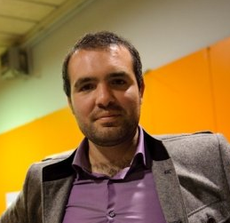Biography:Guillem Anglada-Escudé
From HandWiki
Short description: Spanish astronomer
Guillem Anglada-Escude | |
|---|---|
 Guillem Anglada | |
| Born | 1979 Barcelona |
| Nationality | Spain |
| Alma mater | University of Barcelona PhD |
| Known for | Search for extrasolar planets |
| Awards | Time 100 list of the most influential people in the world (2017) |
| Scientific career | |
| Fields | Astronomy, Planetary science, Astrophysics |
| Institutions | Institut de Ciències de l'Espai (2019-) Queen Mary University of London (2013–2019) University of Hertfordshire (2014-2015) University of Göttingen (2012-2013) Carnegie Institution of Washington (2008-2011) |
| Thesis | Experiments and relativistic models for optical astrometry from space. Application to the Gaia mission (2007) |
| Doctoral advisor | Jordi Torra, Sergei A. Klioner |
| Website | www |
Guillem Anglada-Escudé (born in Ullastrell, Barcelona in 1979), is a Catalan astronomer.[1][2] In 2016, he led a team of astronomers under the Pale Red Dot campaign,[3] which resulted in the confirmation of the existence of Proxima Centauri b, the closest potentially habitable extrasolar planet to Earth, followed by the publication of a peer-reviewed article in Nature.[4][5][6][7][8] In 2017, Anglada-Escudé was named amongst the 100 most influential people according to Time (magazine) ,[9] and one of Nature's top 10 scientists of the year 2016.[10] He is currently a research fellow at Institut de Ciències de l'Espai.[11]
Publications
- Anglada-Escudé, Guillem; Amado, Pedro J.; Barnes, John et al. (2016). "A terrestrial planet candidate in a temperate orbit around Proxima Centauri". Nature 536 (7617): 437–440. doi:10.1038/nature19106. PMID 27558064. Bibcode: 2016Natur.536..437A. https://www.nature.com/articles/nature19106.
- Anglada-Escudé, Guillem; Arriagada, Pamela; Tuomi, Mikko; Zechmeister, Mathias; Jenkins, James S.; Ofir, Aviv; Dreizler, Stefan; Gerlach, Enrico et al. (2014). "Two planets around Kapteyn's star: a cold and a temperate super-Earth orbiting the nearest halo red dwarf". Monthly Notices of the Royal Astronomical Society 443 (1): L89–L93. doi:10.1093/mnrasl/slu076. https://academic.oup.com/mnrasl/article-pdf/443/1/L89/9420242/slu076.pdf.
- Anglada-Escudé, Guillem; Butler, R. Paul (2012). "The HARPS-TERRA project I. Description of the algorithms, performance and new measurements on a few remarkable stars observed by HARPS". The Astrophysical Journal 200 (2): 15. doi:10.1088/0067-0049/200/2/15. Bibcode: 2012ApJS..200...15A.
- Anglada-Escudé, Guillem; Plavchan, Peter; Mills, Sean; Gao, Peter; García-Berríos, Edgardo; Lewis, Nathan S.; Sung, Keeyoon; Ciardi, David et al. (2012). "Design and Construction of Absorption Cells for Precision Radial Velocities in the K Band Using Methane Isotopologues". Publications of the Astronomical Society of the Pacific 124 (916): 586–597. doi:10.1086/666489. Bibcode: 2012PASP..124..586A. https://www.jstor.org/stable/10.1086/666489.
References
- ↑ "NASA Astrobiology Institute". https://astrobiology.nasa.gov/nai/directory/anglada-escude-guillem/.
- ↑ "Finding Proxima b: the 'planet hunters' searching for signs of alien life around nearby stars". Wired UK. https://www.wired.co.uk/article/the-pale-red-dot-proxima-centauri-could-be-home-to-extraterrestrial-life/.
- ↑ "Follow a Live Planet Hunt!". European Southern Observatory. 15 January 2016. https://www.eso.org/public/announcements/ann16002/.
- ↑ "Planet Found in Habitable Zone Around Nearest Star – Pale Red Dot campaign reveals Earth-mass world in orbit around Proxima Centauri". European Southern Observatory. 24 August 2016. https://www.eso.org/public/news/eso1629/.
- ↑ Witze, Alexandra (24 August 2016). "Earth-sized planet around nearby star is astronomy dream come true". Nature 536 (7617): 381–382. doi:10.1038/nature.2016.20445. PMID 27558041. Bibcode: 2016Natur.536..381W. https://www.nature.com/news/polopoly_fs/1.20445!/menu/main/topColumns/topLeftColumn/pdf/nature.2016.20445.pdf. Retrieved 24 August 2016.
- ↑ "Planet Found in Habitable Zone Around Nearest Star". European Southern Observatory. 24 August 2016. https://www.eso.org/public/news/eso1629/.
- ↑ Wall, Mike (24 August 2016). "Found! Potentially Earth-Like Planet at Proxima Centauri Is Closest Ever". https://www.space.com/33834-discovery-of-planet-proxima-b.html.
- ↑ Knapton, Sarah (24 August 2016). "Proxima b: Alien life could exist on 'second Earth' found orbiting our nearest star in Alpha Centauri system". The Telegraph. https://www.telegraph.co.uk/science/2016/08/24/proxima-b-alien-life-could-exist-on-second-earth-found-orbiting/.
- ↑ "Natalie Batalha, Guillem Anglada-Escudé and Michaël Gillon". https://time.com/collection/2017-time-100/4742707/natalie-batalha-guillem-anglada-escude-michael-gillon/.
- ↑ "Nature's 10". Nature 540 (7634): 507–515. 2016. doi:10.1038/540507a. PMID 30905952. Bibcode: 2016Natur.540..507..
- ↑ "Institute of Space Sciences". https://www.ice.csic.es/en/content/4/staff/by-role/0/all.
External links
- https://nai.nasa.gov/directory/anglada-escude-guillem/[yes|permanent dead link|dead link}}]
- https://www.researchgate.net/profile/Guillem_Anglada-Escude
 |

